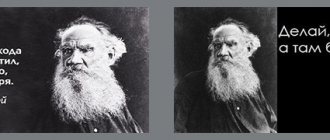The best quotes from the book of Lev Vygotsky (30 quotes)
The famous Soviet psychologist, whose works became fundamental for study at universities and beyond, gave a lot of advice on life in his works. First of all, they were aimed at a person’s ability to think and express. It was these two factors that he defined as key in a person’s life. To think means to live, and to express means to be relevant and necessary. You can agree or disagree with this philosophy. Which side to support is up to you to choose. Next, we invite you to read the best quotes from the book by Lev Vygotsky.
People will understand the meaning of art only then, says Tolstoy, when they stop considering beauty, that is, pleasure, as the goal of this activity.
The feeling or consciousness of low value that arises in an individual as a result of a defect is an assessment of his social position, and it becomes the main driving force of mental development. Overcompensation, “developing the mental phenomena of premonition and foresight, as well as their operating factors such as memory, intuition, attentiveness, sensitivity, interest - in a word, all mental aspects to an enhanced degree” (Alfred Adler), leads to the consciousness of superhealth in a sick body, to the development super-inferiority from inferiority, to the transformation of a defect into giftedness, ability, talent. Demosthenes, who suffered from speech impediments, became the greatest orator of Greece. They say about him that he mastered his great art, deliberately increasing his natural defect, strengthening and multiplying obstacles.
A child needs non-existence only when he is well established in reality.
Every thought strives to connect something with something, to establish a relationship between something and something. Every thought has movement, flow, development, that is, thought performs some function, work, solves some problem.
Depicting murder does not cause murder at all. The scene of adultery does not at all encourage debauchery; The relationship between art and life is very complex...
The task of aesthetics boiled down, as Tolstoy joked, to the demand, “that execution should be painted and that it should look like flowers.”
As Humboldt quite correctly formulated: all understanding is misunderstanding, that is, the processes of thought awakened in us by someone else's speech never completely coincide with those processes that occur in the speaker. Each of us, listening to someone else’s speech and understanding it, approximates the words and their meaning in our own way, and the meaning of the speech will always be subjective for everyone, no more and no less than the meaning of a work of art.
Oh, how we must both despise life and respect it in order to live. The main thing is to be above her, to bully her a little bit (Chekhov) and to be free from her. I am an independent.
A child needs non-existence only when he is well established in reality.
Art is the most important focus of all biological and social processes of the individual in society, that it is a way of balancing a person with the world in the most critical and responsible moments of life.
A creature that is completely adapted to the world around it, such a creature could not desire anything, strive for anything and, of course, could not create anything. Therefore, the basis of creativity is always maladjustment, from which needs, aspirations or desires arise.
Clouds of thoughts, driven by the winds of motives, rain down words.
By its very nature, aesthetic experience remains incomprehensible and hidden in its essence and flow from the subject. We never know or understand why we liked this or that work. Everything we come up with to explain its action is an afterthought, a completely obvious rationalization of unconscious processes. The very essence of experience remains mysterious to us. Art consists in hiding art, as the French proverb says.
Having the end of the path, it is easiest to understand both the entire path as a whole and the meaning of the individual stages.
Overcoming dissonance, resolution and reconciliation must occur. The impression of the terrible must find resolution and purification in the moment of Dionysian ascent; horror is not depicted for its own sake, but as an impulse to overcome it. And this distraction should signify both overcoming and catharsis.
Every concrete phenomenon is completely inexhaustible and infinite in its individual characteristics; one must always look for in a phenomenon what makes it a scientific fact. This is what distinguishes the observation of a solar eclipse by an astronomer from the observation of the same phenomenon by a simply curious person. The first identifies in a phenomenon what makes it an astronomical fact; the second observes random signs that come into the field of his attention.
...it is not enough to formally bring together psychology and history; we must also ask what kind of psychology and what kind of history we are bringing together. Metaphysically, anything can be related to everything.
Let the minds of bold theorists be given the law to strive for "everything or nothing" in attempts at explanation; cautious researchers have to take into account the persistence of facts as a wise counterbalance. After all, trying to explain everything means explaining nothing.
Let’s take for example the history of the Russian word “day”. Originally it meant “seam”, “the place where two pieces of fabric are joined”, “something woven together”. Then it began to designate every joint, corner in a hut, the place where two walls meet. Further, in a figurative sense, it began to mean twilight - the place where day and night meet, and then, covering the time from twilight to twilight, or the period of time including morning and evening twilight, it began to mean “day and night”, i.e. day in the real sense of the word. We see, therefore, that such heterogeneous phenomena as a seam, a corner in a hut, twilight, are united in the historical development of this word into one complex according to the same figurative feature by which a child unites various objects into a complex.
... just as electricity operates and manifests itself not only where there is a majestic thunderstorm and dazzling lightning, but also in the light bulb of a flashlight, so in the same way creativity actually exists not only where it creates great historical works, but also everywhere where a person imagines , combines, changes and creates something new, no matter how small this new thing may seem in comparison with the creations of geniuses.
If we remember the elementary fact that every feeling is an expenditure of the soul, and art is necessarily associated with the stimulation of a complex play of feelings, we will now see that art violates the principle of economy of forces in its immediate action and obeys precisely the opposite principle in the construction of artistic form. Our aesthetic reaction first of all reveals itself to us as a reaction that does not save, but destroys our nervous energy; it is more like an explosion.
It is not difficult to understand that consciousness does not have to be considered biologically, physiologically and psychologically as a second series of phenomena. A place and interpretation must be found for it in the same series of phenomena with all reactions of the body. This is the first requirement for our working hypothesis. Consciousness is a problem of the structure of behavior. Other requirements: the hypothesis must, without exaggeration, explain the main issues associated with consciousness - the problem of conservation of energy, self-awareness, the psychological nature of cognition of other people's consciousnesses, the consciousness of the three main spheres of empirical psychology (thinking, feeling and will), the concept of the unconscious, the evolution of consciousness, identity and its unity.
A child's fantasy is a dialogue with things, a teenager's fantasy is a monologue with things. The teenager recognizes his fantasy as a subjective activity. The child does not yet distinguish his imagination from the things with which he plays.
In fact, psychology teaches us at every step that two actions may proceed identically on the outside, but in their origin, in their essence, in their nature, they can be profoundly different from each other. In these cases, special means of scientific analysis are needed in order to reveal the internal difference behind the external similarity.
Research shows that written speech in the most essential features of development does not at all reproduce the history of oral speech, that the similarity of both processes is more likely externally symptomatic than similar in essence. Written speech is also not a simple translation of oral speech into written signs, and mastering written speech is not simply mastering the technique of writing. In this case, we should have expected that, along with the assimilation of the mechanism of writing, written speech would be as rich and developed as oral speech, and would resemble it as a translation resembles the original. But this also does not take place in the development of written speech.
In order to imitate, I must have some possibility of transition from what I can do to what I cannot do.
The most significant feature of fantasy in adolescence is its division into subjective and objective imagination. Strictly speaking, it is only during adolescence that fantasy is formed for the first time. If we wanted to calculate what in each literary work was created by the author himself and what he received in finished form from the literary tradition, we would very often, almost always, find that only the choice of certain elements should be attributed to the share of personal authorship. their combination, variation within certain limits of generally accepted patterns, transfer of some traditional elements to other systems, etc. In other words, in both the Arkhangelsk storyteller and Pushkin we can always detect the presence of both aspects - both personal authorship and literary traditions. The only difference is in the quantitative ratio of both of these moments. For Pushkin, the moment of personal authorship comes forward, for the storyteller - the moment of literary tradition. But both of them resemble, in Silversvan's apt comparison, a swimmer floating down a river, the current of which carries him to the side. The path of a swimmer, like the work of a writer, will always be the resultant of two forces - the personal efforts of the swimmer and the deflecting force of the current.
It’s not difficult to be a materialist in physiology—try being one in psychology.
But whoever examines the facts inevitably examines them in the light of one theory or another.
Let the minds of bold theorists be given the law to strive for "everything or nothing" in attempts at explanation; cautious researchers have to take into account the persistence of facts as a wise counterbalance. After all, trying to explain everything means explaining nothing.
Biography of L.S. Vygotsky
L.S. Vygotsky was born on November 17, 1896 in Orsha, the second child in a large family of a bank employee. In 1897, the family moved to Gomel, where it became a kind of cultural center (the father is the founder of the public library).
Lev was a gifted boy and was educated at home. From 1912 he completed his studies at a private gymnasium.
In 1914, after graduating from high school, Vygotsky entered the medical faculty of Moscow State University, and a month later he was transferred to law and graduated in 1917. At the same time, he received an education at the Faculty of History and Philology of the Shanyavsky University.
In 1917, with the beginning of the revolution, the young man returned to Gomel. The Gomel period lasted until 1924 and was the beginning of his psychological and pedagogical activity. Here he marries and has a daughter.
At first he gave private lessons, then taught a course in philology and logic at various schools in the city, and took an active part in the formation of a new type of school. He also taught philology at the Pedagogical College, where he created a consulting room for psychology. Here Vygotsky began his psychological research.
In 1920, Lev contracted tuberculosis from his brother, who died.
In 1924 he was invited to the Moscow Institute of Experimental Psychology. From that moment on, the Moscow period of the scientist’s family began.
In 1924 – 1925 Vygotsky created his own cultural and historical psychological school on the basis of the institute. He began to become interested in working with special needs children. Continuing his psychological research, he simultaneously worked in the People's Commissar of Education, where he proved himself to be a talented organizer.
Through his efforts, an experimental defectology institute was created in 1926 (now the Institute of Correctional Pedagogy). He headed it until the end of his life. Vygotsky continues to write and publish books. From time to time the illness put him out of action. In 1926 there was a very severe outbreak.
From 1927 – 1931 The scientist published works on the problems of cultural-historical psychology. During these same years, he began to be accused of retreating from Marxism. It became dangerous to study psychology, and Vygovsky devoted himself to pedology.
The disease periodically worsened, and in 1934 Lev Semenovich died in Moscow.
Zone of Proximal Development Theory
The zone of proximal development is the “distance” between the level of a child’s actual and possible development.
- The level of actual development is the development of the child’s psyche at the moment (which tasks can be completed independently).
- The zone of proximal development is the future development of the individual (actions that are performed with the help of an adult).
This is based on the assumption that a child, learning some elementary action, simultaneously masters the general principle of this action. Firstly, this action itself has a wider application than its element. Secondly, having mastered the principle of action, you can apply it to perform another element.
This will be an easier process. There is development in the learning process.
But learning is not the same as development: learning does not always push development; on the contrary, it can become a brake if we rely only on what the child can do and do not take into account the level of his possible development.
Learning will become developmental if we focus on what the child can learn from previous experience.
The size of the zone of proximal development is different for each child.
It depends:
- on the needs of the child;
- from its capabilities;
- on the willingness of parents and teachers to assist in the development of the child.
Criticism of Vygotsky's ideas
Vygotsky's research and ideas on psychological pedagogy were subjected to the most vehement condemnation.
His concept of learning, based on the zone of proximal development, carries the danger of pushing forward a child who does not have sufficient potential. This can dramatically slow down children's development.
This is partly confirmed by the current fashionable trend: parents strive to develop their children as much as possible, without taking into account their abilities and potential. This dramatically affects the health and psyche of children and reduces motivation for further education.
Another controversial concept: systematically helping a child perform actions that he has not mastered on his own can deprive the child of independent thinking.
Unified Labor School
It was the prototype of a democratic school based on a creative, dynamic, collaborative pedagogy. It was ahead of its time, imperfect, and made mistakes, but it was still successful.
Vygotsky’s ideas were implemented by teachers Blonsky, Wenzel, Shatsky and others.
The pedological theory was tested at the school:
- there were rooms for psychological and pedological diagnostics;
- constant medical and psychological monitoring was carried out;
- classes were created according to the principle of the child’s pedological age.
This school existed until 1936, when the Soviet authorities began attacking it. The school was repurposed as a regular one.
The very idea of pedology was distorted, and it fell into oblivion. Pedology and the idea of a labor school received a second life in the 90s. with the collapse of the USSR. A unified labor school in the modern sense is a democratic school, very appropriate in today's education.
Main directions of Vygotsky's research
Vygotsky was, first and foremost, a psychologist. He chose the following areas of research:
- comparison of adults and children;
- comparison of modern man and ancient man;
- comparison of normal personality development with pathological behavioral deviations.
The scientist drew up a program that determined his path in psychology: to look for an explanation of internal mental processes outside the body, in its interaction with the environment. The scientist believed that these mental processes can only be understood through development. And the most intensive development of the psyche occurs in children.
This is how Vygotsky came to an in-depth study of child psychology. He studied the patterns of development of normal and abnormal children. In the process of research, the scientist came to study not only the process of child development, but also his upbringing. And since pedagogy is the study of education, Vygotsky began research in this direction.
He believed that any teacher should base his work on psychological science. This is how he connected psychology with pedagogy. And a little later, a separate science in social pedagogy emerged - psychological pedagogy.
While engaged in pedagogy, the scientist became interested in the new science of pedology (knowledge about the child from the point of view of various sciences) and became the main pedologist of the country.
He put forward ideas that revealed the laws of cultural development of the individual, his mental functions (speech, attention, thinking), explained the internal mental processes of the child, his relationship with the environment.
His ideas on defectology laid the foundation for correctional pedagogy, which began to practically help special children.
Vygotsky did not develop methods for raising and developing children, but his concepts of the proper organization of education and upbringing became the basis of many developmental programs and systems. The scientist’s research, ideas, hypotheses and concepts were far ahead of their time.
The influence of communication on raising a child
A child develops quickly and masters the world around him if he communicates with an adult. At the same time, the adult himself should be interested in communication. It is very important to encourage your child's verbal communication.
Speech is a sign system that arose in the process of socio-historical development of man. It is able to transform children's thinking, helps solve problems and form concepts. At an early age, a child’s speech uses words with a purely emotional meaning.
As children grow and develop, words of specific meaning appear in their speech. In older adolescence, the child begins to designate abstract concepts in words. Thus, speech (word) changes the mental functions of children.
The mental development of a child is initially controlled by communication with an adult (through speech). Then this process moves into the internal structures of the psyche, and inner speech appears.
Principles of raising children according to Vygotsky
The scientist believed that education does not consist in adapting the child to the environment, but in the formation of a personality that goes beyond this environment, as if looking forward. At the same time, the child does not need to be educated from the outside, he must educate himself.
This is possible with proper organization of the education process. Only the personal activity of a child can become the basis of education.
The teacher should only be an observer, correctly guide and regulate the child’s independent activity at the right moments.
Thus, education becomes an active process from three sides:
- the child is active (he performs an independent action);
- the teacher is active (he observes and helps);
- The environment between the child and the teacher is active.
Education is closely related to learning. Both processes are collective activities. The structure of the new labor school, which Vygotsky created with his students, is based on the principles of the collective process of education and training.
Vygotsky's merits in pedology
At the beginning of the 20th century, educational psychology appeared, which was based on the fact that learning and upbringing depend on the psyche of a particular child.
The new science did not solve many problems of pedagogy. An alternative was pedology - a comprehensive science about the full age development of a child. The center of study in it is the child from the point of view of biology, psychology, sociology, anthropology, pediatrics, and pedagogy. The hottest problem in pedology was the socialization of the child.
It was believed that child development proceeds from the individual mental world to the external world (socialization). Vygotsky was the first to postulate that the social and individual development of a child are not opposed to each other. They are simply two different forms of the same mental function.
He believed that the social environment is the source of personal development. The child absorbs (makes internal) those activities that came to him from the outside (were external). These types of activities are initially enshrined in social forms of culture. The child adopts them by seeing how other people perform these actions.
Those. external social and objective activity passes into the internal structures of the psyche (interiorization), and through general social-symbolic activity (including through speech) of adults and children the basis of the child’s psyche is formed.
Vygotsky formulated the basic law of cultural development:
In the development of a child, any function appears twice - first in the social aspect, and then in the psychological (i.e., first it is external, and then it becomes internal).
Vygotsky believed that this law determines the development of attention, memory, thinking, speech, emotions, and will.
Development and education of special children
Vygotsky developed a new theory of abnormal child development, on which defectology is now based and all practical correctional pedagogy is built. The purpose of this theory: the socialization of special children with a defect, and not the study of the defect itself. It was a revolution in defectology.
He connected special correctional pedagogy with the pedagogy of a normal child. He believed that the personality of a special child is formed in the same way as that of ordinary children. It is enough to socially rehabilitate an abnormal child, and his development will follow the normal course.
His social pedagogy was supposed to help the child remove the negative social layers caused by the defect. The defect itself is not the cause of the child’s abnormal development, it is only a consequence of improper socialization.
The starting point in the rehabilitation of special children should be an unaffected state of the body. “We should work with the child based on what is healthy and positive,” Vygotsky.
By starting rehabilitation, you can also start the compensatory capabilities of the special child’s body. The idea of the zone of proximal development has become very effective in restoring the normal development of special children.








